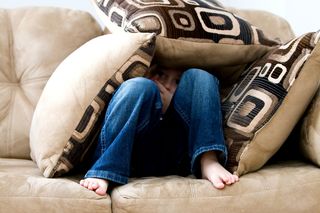
Anxiety
5 Reasons for High Anxiety in Childhood Autism
Identifying the causes of anxiety is the first step to relief.
Posted May 1, 2019 Reviewed by Abigail Fagan

Anxiety is a pervasive problem in autism. This is the case across the full age range including for children and adolescents. Consider the following three findings:
- Children on the autism spectrum are more likely to suffer from anxiety, with close to 40 percent having at least one diagnosable anxiety disorder (Van Steennel, Bögels, & Perrin, 2011)
- Parents often report that the impact of anxiety in their children can be more substantial than the impact of autism itself (Ozsivadjian, Knott, & Magiati, 2012).
- Anxiety has been found to contribute to—and interact with—sleep problems and challenging behavior in autistic children (Rzepecka, McKenzie, McClure, & Murphy, 2011).
These findings echo my clinical experience as a child psychologist. Although anxiety is not listed as a core symptom of autism, it is often the primary reason why children on the spectrum are brought to my office.
Why do I need to find the cause of anxiety before treating it?
Knowing the factors that contribute to anxiety will lead you to the best solutions. It's sort of like having a car that's making a funny sound. You need to find out what's making the sound before going in and changing parts. The cause of the sound is going to lead to the solution. Symptoms of anxiety are the "sounds" that are telling you something is wrong. However, you need to find out what's causing the anxiety before addressing it.
What causes so much anxiety in children on the autism spectrum?
Kids on the autism spectrum can be anxious for all of the reasons that any other children can (school, family, health, and so on). However, there are additional challenges that come along with autism that can create additional anxiety. I find that these additional factors tend to fall into five categories. I call them my Five Prime Suspects:
- Cognitive Rigidity. People on the spectrum tend to process the world by details. This can be a wonderful strength (for example, strong factual memory and attention to detail). However, processing by details rather than by context can create anxiety during times of change or transition. Without context, a child on the spectrum can be thrown off and confused when changes occur unexpectedly or when she has to shift from one situation to another. This confusion can rapidly lead to anxiety.
- Sensory Sensitivities. Children on the spectrum have difficulty with regulating sensory input. Sensations that wouldn't bother most kids may seem harsh to the child on the spectrum and this can lead to high levels of distress. Sensitivities can occur with the traditional senses—hearing, sight, taste, touch, smell—but can also extend to other senses such as balance, temperature, and pain.
- Communication Barriers. There is a high occurrence of speech and language processing disorders in autism. When not adequately accommodated for, these disorders can create frustration and anxiety in situations that place high demands on communication skills.
- Social Challenges. Social situations can pose a number of challenges for kids on the spectrum. Difficulty with understanding social rules and nuances can create strain and anxiety; particularly in large, unstructured situations such as recess or a birthday party.
- Task Frustration. Kids on the spectrum have many talents. However, there are some areas that they may struggle in. Common areas of struggle include fine motor tasks, reading comprehension, and expressive writing. It's not that kids on the spectrum can't improve at these tasks (they certainly can, and do!) However, there may be times when they require additional supports and accommodations to reduce frustration and anxiety.
Which suspects are responsible for my child or student's anxiety?
Identifying which of the suspects are responsible for anxiety takes some detective work. Ask these questions:
- Where does my child display anxiety?
- When does my child show signs of anxiety?
- Who is around when my child shows signs of anxiety?
- What demands are being placed on my child when she seems anxious?
- When is my child usually calmest?
The answers to these types of questions can lead to clues and hypotheses about which factors are driving your child's distress. Bear in mind that there is often more than one suspect contributing to your child's anxiety at any given time.

From Assessment to Treatment
Once you determine which suspects are causing anxiety, it's time to plan and take action. Some common solutions for each of the Five Suspects include:
Cognitive Rigidity: Prepare for upcoming changes, use visual supports to guide through transitions, and maintain a reasonable degree of structure and consistency.
Sensory Sensitivities: Minimize harsh stimulation (e.g. reduce noise, use natural lighting, avoid strong smells), and use tools and technology (e.g. noise cancellation headphones, soft light bulbs, sound absorbing tiles).
Communication Barriers: Use visual supports, add coping-related words and phrases to communication systems, and use reduced language during times of distress.
Social Challenges: Set up smaller, more structured social situations to boost confidence, assist with decoding social rules, and work with others to increase understanding and tolerance.
Task Frustration: Provide accommodations to address areas of struggle, modify tasks to suit each child's unique learning style, alternate frustrating tasks that play to strengths, and provide with breaks as necessary.
Conclusion
Anxiety is a pervasive problem for children on the autism spectrum. However, careful assessment of the causes of this anxiety will lead to effective strategies for relief.
LinkedIn Image Credit: Saharak Wutthitham/Shutterstock
References
Oszivadjian, A., Knott, F., & Magiati, I. (2012). Parent and child perspectives on the nature of anxiety in children and young people with autism spectrum disorders: a focus group study, Autism, 16(2), 107-121.
Rzepecka, H.,McKenzie, K., McClure, I., & Murphy, S. (2011). Sleep, anxiety, and challenging behavior in children with intellectual disability and/or autism spectrum disorder. Reseach in Developmental Disabilities, 32 (6), 2758-2766.
Van Steensel, F.J., Bögels, S.M., & Perrin, S. (2011). Anxiety disorders in children and adolescents with autism spectrum disorders: a meta-analysis. Clinical Child and Family Psychology Review, 14 (3), 302.

